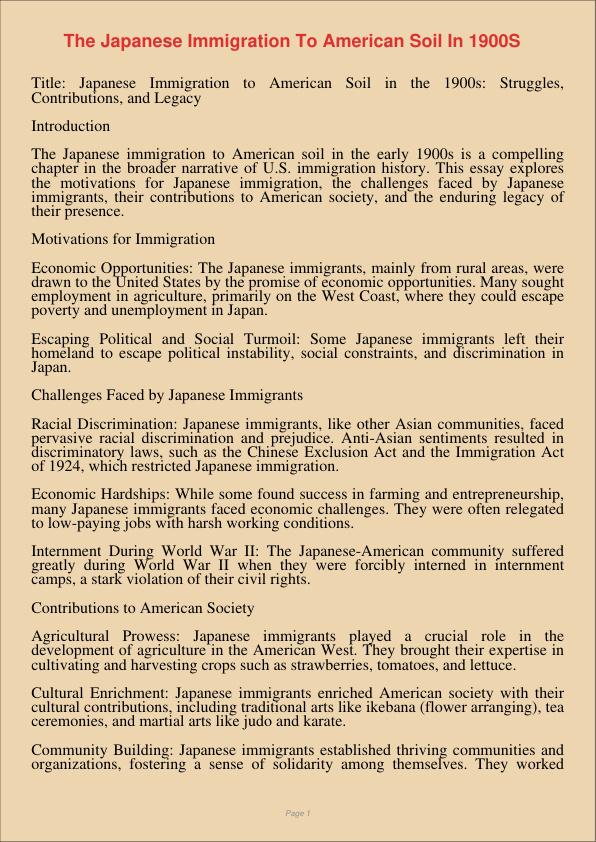The Japanese Immigration To American Soil In 1900S
Jan 6, 2024
japanese immigration
american soil
Business
Health Sciences & Medicine

Title: Japanese Immigration to American Soil in the 1900s: Struggles, Contributions, and Legacy
Introduction
The Japanese immigration to American soil in the early 1900s is a compelling chapter in the broader narrative of U.S. immigration history. This essay explores the motivations for Japanese immigration, the challenges faced by Japanese immigrants, their contributions to American society, and the enduring legacy of their presence.
Motivations for Immigration
Economic Opportunities: The Japanese immigrants, mainly from rural areas, were drawn to the United States by the promise of economic opportunities. Many sought employment in agriculture, primarily on the West Coast, where they could escape poverty and unemployment in Japan.
Escaping Political and Social Turmoil: Some Japanese immigrants left their homeland to escape political instability, social constraints, and discrimination in Japan.
Challenges Faced by Japanese Immigrants
Racial Discrimination: Japanese immigrants, like other Asian communities, faced pervasive racial discrimination and prejudice. Anti-Asian sentiments resulted in discriminatory laws, such as the Chinese Exclusion Act and the Immigration Act of 1924, which restricted Japanese immigration.
Economic Hardships: While some found success in farming and entrepreneurship, many Japanese immigrants faced economic challenges. They were often relegated to low-paying jobs with harsh working conditions.
Internment During World War II: The Japanese-American community suffered greatly during World War II when they were forcibly interned in internment camps, a stark violation of their civil rights.
Contributions to American Society
Agricultural Prowess: Japanese immigrants played a crucial role in the development of agriculture in the American West. They brought their expertise in cultivating and harvesting crops such as strawberries, tomatoes, and lettuce.
Cultural Enrichment: Japanese immigrants enriched American society with their cultural contributions, including traditional arts like ikebana (flower arranging), tea ceremonies, and martial arts like judo and karate.
Community Building: Japanese immigrants established thriving communities and organizations, fostering a sense of solidarity among themselves. They worked together to support one another and preserve their cultural heritage.
Enduring Legacy
Cultural Heritage: Japanese cultural influences are still evident in the United States today, from sushi restaurants to the annual cherry blossom festivals that celebrate Japan’s gift of cherry trees to Washington, D.C.
Civil Rights Advocacy: The struggle for civil rights by Japanese Americans during and after World War II had a profound impact on American society, contributing to the broader civil rights movement. Fred Korematsu’s legal challenge to the internment order, for example, has left a lasting legacy in the fight against racial discrimination.
Japanese-Americans in Prominent Positions: Japanese-Americans have excelled in various fields, including politics, business, sports, and the arts. Notable figures like Daniel Inouye, Yuri Kochiyama, and George Takei have made significant contributions to American society.
Conclusion
The Japanese immigration to American soil in the early 1900s represents a significant chapter in the broader story of U.S. immigration history. Japanese immigrants faced daunting challenges, from racial discrimination to economic hardships, yet they contributed significantly to American society through their work in agriculture, cultural enrichment, and community building. Their legacy endures not only in cultural influences but also in the fight for civil rights and the achievements of Japanese-Americans in various fields. The story of Japanese immigration serves as a testament to the resilience and contributions of immigrants to the United States, as well as a reminder of the ongoing struggle for social justice and equality.